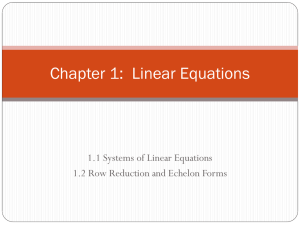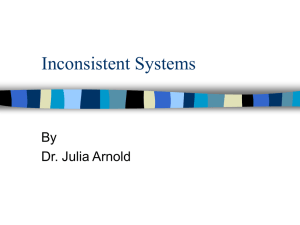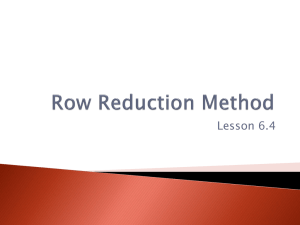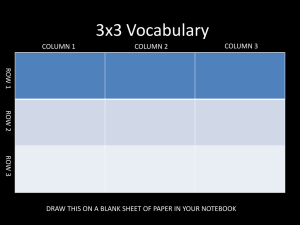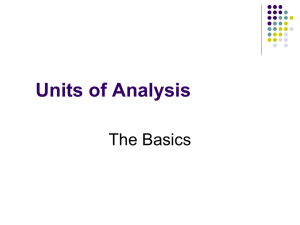Chapter 1 Notes
advertisement
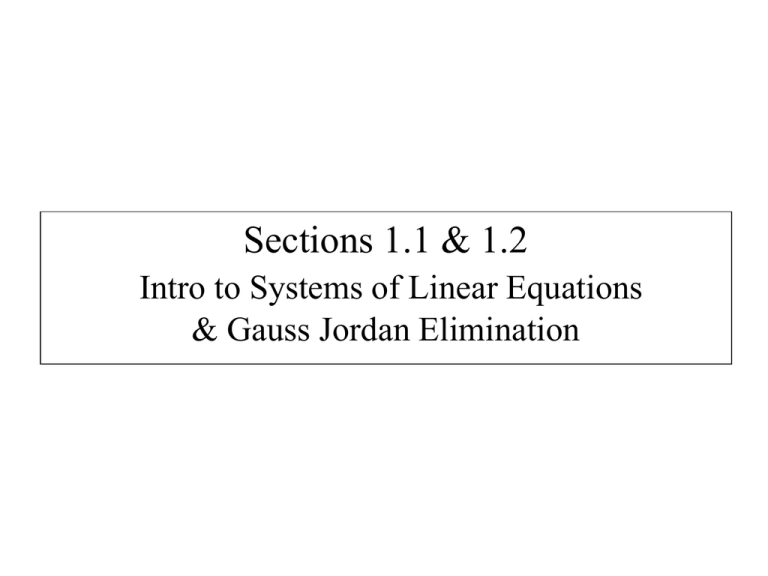
Sections 1.1 & 1.2 Intro to Systems of Linear Equations & Gauss Jordan Elimination Linear Algebra – Linear Equations y = 3x – 2 2x – 3y + 4z = 9 Vector Spaces A solution to an equation. A solution to multiple equations (a system of equations). A parametric representation of a solution. Geometrical meaning of a solution. For two equations in two unknowns: One Solution No Solutions 2x + 3y = 6 4x – 2y = 12 2x + 3y = 6 4x + 6y = –24 Infinite Solutions 2x + 3y = 6 4x + 6y = 12 Geometrical meaning of a solution. For three equations in three unknowns: Geometrical meaning of a solution. For three equations in three unknowns: The number of solutions to a system of linear equations. A system is consistent if there is at least one solution to it. A system is inconsistent if there is no solution for it. Equivalent systems – systems that have the same solution set. Hard to solve: x – 2y + 3z = 9 –x + 3y = –4 2x – 5y + 5z = 17 Easy to solve: → x + 0y + 0z = 1 0x + y + 0z = –1 0x + 0y + z = 2 Hard to solve: x – 2y + 3z = 9 –x + 3y = –4 2x – 5y + 5z = 17 1 2 3 Easy to solve: x → y =1 = –1 z =2 Elementary Operations: 1. Interchange any two equations. 2. 3. x – 2y + 3z = 9 –2x + 3y + 7z = –4 2x – 5y + 5z = 17 –2x + 3y + 7z = –4 x – 2y + 3z = 9 2x – 5y + 5z = 17 Elementary Operations: 1. 2. Multiply any equation by a nonzero scalar. 3. x – 2y + 3z = 9 –2x + 3y + 7z = –4 2x – 5y + 5z = 17 x – 2y + 3z = 9 –2x + 3y + 7z = –4 20x – 50y + 50z = 170 Elementary Operations: 1. 2. 3. Add a multiple of one equation to another equation. x – 2y + 3z = 9 –2x + 3y + 7z = –4 2x – 5y + 5z = 17 x – 2y + 3z = 9 –2x + 3y + 7z = –4 2x – 5y + 5z = 17 2x – 4y +12z = 18 –2x + 3y + 7z = –4 2x – 5y + 5z = 17 2x – 4y + 12z = 18 – y + 19z = 14 2x – 5y + 5z = 17 x – 2y + 3z = 9 – y + 19z = 14 2x – 5y + 5z = 17 Gauss Jordan Elimination: x – 2y + 3z = 9 –x + 3y = –4 2x – 5y + 5z = 17 → x + 0y + 0z = 1 0x + y + 0z = –1 0x + 0y + z = 2 Gaussian Elimination: x – 2y + 3z = 9 –x + 3y = –4 2x – 5y + 5z = 17 → x – 2y + 3z = 9 0x + y + 3z = 5 0x + 0y + z = 2 Ex. Use Gauss Jordan elimination to solve the system (method of elimination) x – 2y + 3z = 9 y + 3z = 5 2x – 5y + 5z = 17 x – 2y + 3z = 9 y + 3z = 5 –y – z = –1 x – 2y + 3z = 9 y + 3z = 5 2z = 4 x + 9z = 19 y + 3z = 5 2z = 4 x – 2y + 3z = 9 –x + 3y = –4 2x – 5y + 5z = 17 Ex. Use Gauss Jordan elimination to solve the system x + 9z = 19 y + 3z = 5 2z = 4 x – 2y + 3z = 9 –x + 3y = –4 2x – 5y + 5z = 17 Ex. Use Gauss Jordan elimination to solve the system x + 9z = 19 y + 3z = 5 2z = 4 x+ 9z = 19 y + 3z = 5 z=2 x+ y 9z = 19 = –1 z=2 y =1 = –1 z =2 x x – 2y + 3z = 9 –x + 3y = –4 2x – 5y + 5z = 17 Notice that we can use elementary row operations on a matrix to work through the Gauss Jordan method of elimination. 1 2 3 9 x – 2y + 3z = 9 1 3 0 4 –x + 3y = –4 2x – 5y + 5z = 17 2 5 5 17 x – 2y + 3z = 9 1 2 3 9 y + 3z = 5 R2+R1→R2 0 1 3 5 2x – 5y + 5z = 17 2 5 5 17 x – 2y + 3z = 9 1 2 3 9 0 1 3 5 y + 3z = 5 –y – z = –1 R3–2R1→R3 0 1 1 1 x – 2y + 3z = 9 1 2 3 9 y + 3z = 5 0 1 3 5 2z = 4 R3+R2→R3 0 0 2 4 x + 9z = 19 1 0 9 19 y + 3z = 5 0 1 3 5 2z = 4 R1+2R2→R3 0 0 2 4 Notice that we can use elementary row operations on a matrix to work through the Gauss Jordan method of elimination. x – 2y + 3z = 9 –x + 3y = –4 2x – 5y + 5z = 17 x + 9z = 19 y + 3z = 5 2z = 4 1 0 9 19 0 1 3 5 0 0 2 4 Notice that we can use elementary row operations on a matrix to work through the Gauss Jordan method of elimination. x – 2y + 3z = 9 –x + 3y = –4 2x – 5y + 5z = 17 x + 9z = 19 y + 3z = 5 2z = 4 x + 9z = 19 y + 3z = 5 z=2 x =1 y + 3z = 5 z=2 x y =1 = –1 z =2 1 0 9 19 0 1 3 5 0 0 2 4 1 0 ½ R3→R3 0 R1–9R3→R1 1 0 0 R2–3R3→R2 0 9 19 1 3 5 0 1 2 0 0 1 1 3 5 0 1 2 1 0 0 1 0 1 0 1 0 0 1 2 Elementary Row Operations (We are allowed to use these operations on a matrix when trying to solve a system of linear equations.) Elementary Row Operation: 1. Interchange two rows 2. Multiply (or divide) a row by a nonzero constant. 3. Add (or subtract) a multiple of one row to another. Notation: Ri ↔ Rk cRi → Ri Ri + cRk → Ri We'd like to take our original augmented matrix, and through row operations put it in the following form: 1 0 0 0 0 0 b1 b 0 1 0 0 0 0 2 0 0 1 0 0 0 b3 b 0 0 0 1 0 0 4 0 0 0 0 1 0 bn1 b 0 0 0 0 0 1 n where the bi's are just some constants (some numbers). For example, this matrix has a solution that is easy to see, (1, 3, 5), because the matrix is in the final form that we want. 1 0 0 1 0 1 0 3 0 0 1 5 This is not always possible though. The following are matrices that cannot be put into this form. 1 2 3 7 0 0 0 0 0 0 0 0 1 0 5 2 0 1 6 3 Reduced Row Echelon Form A matrix is said to be in reduced echelon form if all of the following properties hold true: 1. All rows consisting entirely of zeros are grouped at the bottom. 2. The leftmost nonzero number in each row is 1 (called the leading one). 3. The leading 1 of a row is to the right of the previous row's leading 1. 4. All entries directly above and below a leading 1 are zeros. Reduced Row Echelon Form A matrix is said to be in reduced echelon form if all of the following properties hold true: 1. All rows consisting entirely of zeros are grouped at the bottom. 2. The leftmost nonzero number in each row is 1 (called the leading one). 3. The leading 1 of a row is to the right of the previous row's leading 1. 4. All entries directly above and below a leading 1 are zeros. Gauss Jordan Elimination: x – 2y + 3z = 9 –x + 3y = –4 2x – 5y + 5z = 17 x → y =1 = –1 z =2 Gaussian Elimination: x – 2y + 3z = 9 –x + 3y = –4 2x – 5y + 5z = 17 1 2 3 9 1 3 0 4 2 5 5 17 → x – 2y + 3z = 9 y + 3z = 5 z =2 1 0 0 1 0 1 0 1 0 0 1 2 Reduced Row Echelon Form 1 2 3 9 0 1 3 5 0 0 1 2 Row Echelon Form Ex. Determine which of the following matrices are in reduced row echelon form. (a) 1 0 0 4 (b) 1 0 0 3 (c) 1 0 0 2 0 1 0 4 0 1 0 5 0 0 1 4 0 0 0 0 0 0 1 2 0 1 0 1 0 0 1 5 Reduced Row Echelon Form 1. All rows consisting entirely of zeros are grouped at the bottom. 2. The leftmost nonzero number in each row is 1 (called the leading one). 3. The leading 1 of a row is to the right of the previous row's leading 1. 4. All entries directly above and below a leading 1 are zeros. Ex. Determine which of the following matrices are in reduced row echelon form. (d) 1 0 0 0 4 0 0 1 0 5 0 0 0 1 7 (e) 1 0 3 4 0 1 2 1 0 0 0 0 (f) 1 0 3 0 1 2 0 0 0 Reduced Row Echelon Form 1. All rows consisting entirely of zeros are grouped at the bottom. 2. The leftmost nonzero number in each row is 1 (called the leading one). 3. The leading 1 of a row is to the right of the previous row's leading 1. 4. All entries directly above and below a leading 1 are zeros. Ex. Determine which of the following matrices are in reduced row echelon form. (g) 1 0 0 2 0 1 0 4 (h) 2 0 0 3 0 1 0 5 0 0 1 7 Reduced Row Echelon Form 1. All rows consisting entirely of zeros are grouped at the bottom. 2. The leftmost nonzero number in each row is 1 (called the leading one). 3. The leading 1 of a row is to the right of the previous row's leading 1. 4. All entries directly above and below a leading 1 are zeros. 1 3 11 Ex. Put the matrix A 3 4 6 into reduced row echelon form. 2 7 17 1 3 11 3 4 6 2 7 17 1 3 11 0 13 39 0 13 39 1 3 11 0 1 3 0 13 39 1 0 0 1 0 0 2 3 0 R2 – 3R1→R2 R3 – 2R1→R3 –1/ R →R 13 2 2 R1 – 3R2→R1 R3 + 13R2→R3 Using a calculator with matrices. Ex. Solve the following system. x + y = 11 3x – 4y = –6 2x – 7y = –17 1 1 11 3 4 6 2 7 17 1 1 11 0 7 39 0 9 39 1 0 0 1 0 0 39 7 78 7 38 7 1 0 0 0 1 0 0 0 1 Ex. Solve the following system of equations. 1 4 7 2 9 4 1 3 17 3 7 2 1 4 7 0 1 10 0 1 10 3 1 1 1 0 47 0 1 10 0 0 0 1 1 0 x1 – 4x2 + 7x3 = –3 –2x1 + 9x2 – 4x3 = 7 x1 – 3x2 + 17x3 = –2 Ex. Solve the following system of equations. (A graph of this system is given below.) Here's one view of the three planes: x1 – 4x2 + 7x3 = –3 –2x1 + 9x2 – 4x3 = 7 x1 – 3x2 + 17x3 = –2 Here's a side view of the three planes: Ex. Solve the following system of equations. 1 2 3 2 4 6 3 6 9 1 2 3 0 0 0 0 0 0 4 8 12 4 0 0 x1 – 2x2 + 3x3 = 4 –2x1 + 4x2 – 6x3 = –8 3x1 – 6x2 + 9x3 = 12 Ex. Solve the following system of equations. (A graph of this system is given below.) Here's one view of the three planes: x1 – 2x2 + 3x3 = 4 –2x1 + 4x2 – 6x3 = –8 3x1 – 6x2 + 9x3 = 12 Here's a side view of the three planes: Notation and terminology If we call a matrix A then we shall refer to the entries in A as follows: ai j is the number in matrix A in row i column j. If we call a matrix A then we shall refer to the entries in A as follows: ai j is the number in matrix A in row i column j. 11 13 3 If A 6 5 1 then we have the following: 4 0 2 a1 2 = 13 1 3 4 If B then we have the following: 2 2 1 b1 2 = 3 a3 1 = –4 b2 3 = 1 Given a system like –5x + 6y – 2z = 11 we will often look at the following x + 3y = 2 two matrices. 2x – y + z = 4 Coefficient Matrix 5 6 2 1 3 0 2 1 1 Augmented Matrix 5 6 2 11 1 3 0 2 2 1 1 4 Homogenous systems 8x – 2y + 6z = 0 9x + 3y + 7z = 0 4x – 5y + 2z = 0 13x – 8y + 2z = 0 2x + 4y –10z = 0 5x – 7y + 3z = 0 x + 3y + 5z = 0

